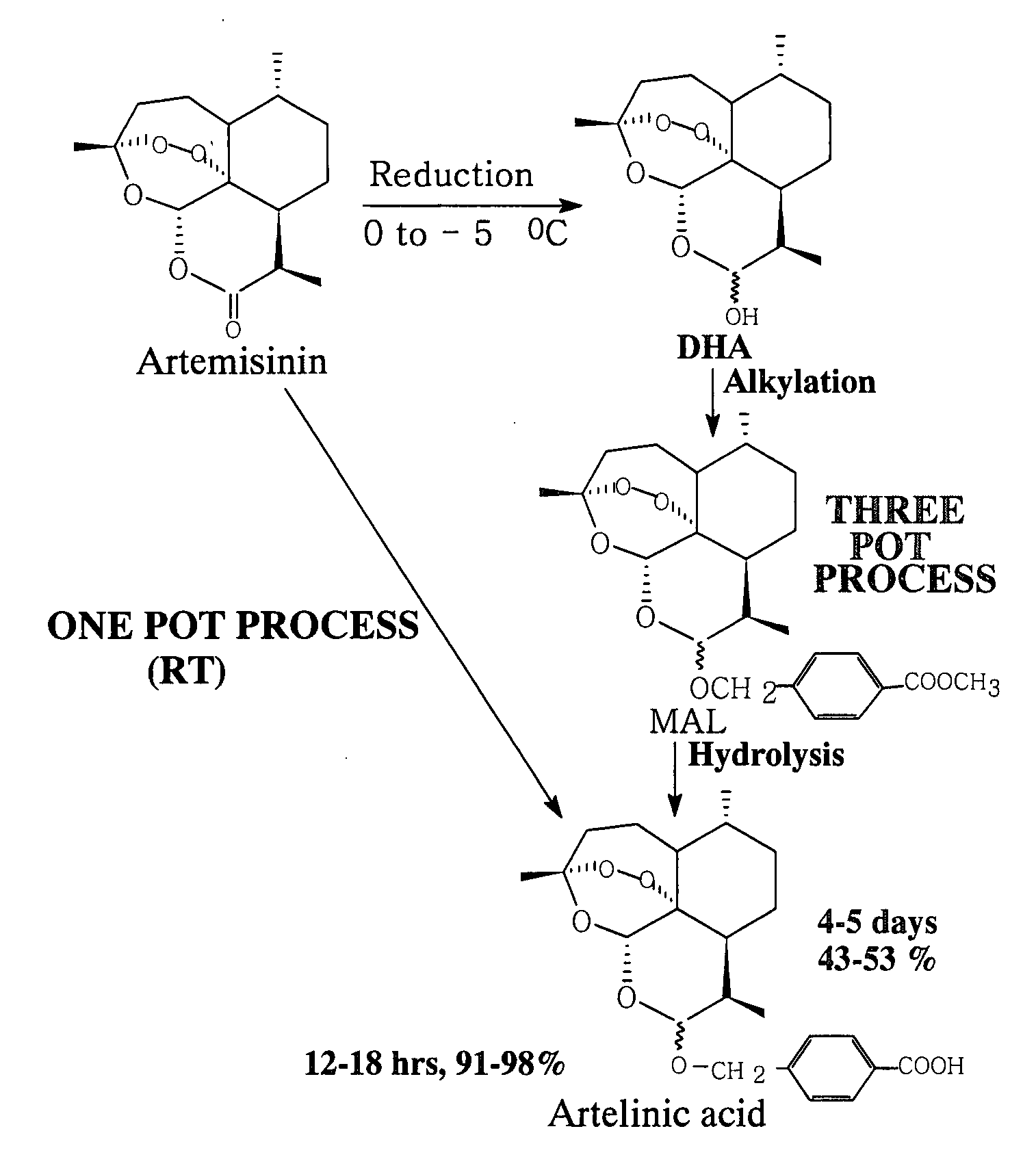Process for one pot conversion of artemisinin into artelinic acid
a technology of artemisinin and artelinic acid, which is applied in the field of one pot conversion of artemisinin into artelinic acid, can solve the problems of poor stability in aqueous solution, limited range of malaria drugs available, and increased time consumption,
- Summary
- Abstract
- Description
- Claims
- Application Information
AI Technical Summary
Benefits of technology
Problems solved by technology
Method used
Image
Examples
example 1
[0078] Artemisinin (1.0 g), polyhydroxy compound (dextrose, 5.0 g), sodium borohydride (2.0 g) and methyl p-(hydroxymethyl) benzoate (2.1 g) and chlorotrimethylsilane (CTMS) (1.0 ml) were stirred in 1,4-dioxan (40 ml) at room temperature at 25° C. for about 7 hrs. It was filtered. The filterate was further stirred with 10% KOH / H2O (75 ml) for about 2 hrs. The reaction mixture was neutralized with 5% CH3COOH, extracted with ethyl acetate (2×60 ml). The ethyl acetate extract was dried over anhydrous sodium sulphate and evaporation of solvent yielded impure artelinic acid (1.25 gm) which was recrystallized in ethyl acetate-hexane to yield pure artelinic acid in 98% yield (980 mg). After thorough drying the pure artelinic acid, m.p 142-415° C. was characterized by spectral analysis.
example 2
[0079] Artemisinin (50 mg), PHC (dextrose, 250 mg), sodium borohydride (100 mg) and methyl p-(hydroxymethyl) benzoate (100 mg) and chlorotrimethylsilane (CTMS) (0.1 ml) were stirred in tetrahydrofuran (3 ml) at room temperature at 20° C. for about 8.0 hrs. After completion of the reduction and alkylation reaction it was filtered. In the filtrate, 10% KOH / MeOH (15 ml) was added slowly at room temperature and the reaction mixture was stirred further for 3.5 hours at room temp. After usual work up and purification through prep TLC, yielded 16 mg (32%) artelinic acid.
example 3
[0080] Artemisinin (50 mg), phloroglucinol (300 mg), sodium borohydride (150 mg) and methyl p-(hydroxymethyl) benzoate (150 mg) and chlorotrimethylsilane (CTMS) (0.05 ml) were stirred in tetrahydrofuran (4 ml) at room temperature at 25° C. for about 8.0 hrs. The reaction mixture was filtered. In the filtrate 10% KOH / MeOH (15 ml) was added slowly at room temperature and the reaction mixture was stirred further for 3 hours at room temp. After usual work up and purification through prep TLC yielded 11 mg (22%) pure artelinic acid.
PUM
| Property | Measurement | Unit |
|---|---|---|
| temperature | aaaaa | aaaaa |
| time | aaaaa | aaaaa |
| temperature | aaaaa | aaaaa |
Abstract
Description
Claims
Application Information
 Login to View More
Login to View More - R&D Engineer
- R&D Manager
- IP Professional
- Industry Leading Data Capabilities
- Powerful AI technology
- Patent DNA Extraction
Browse by: Latest US Patents, China's latest patents, Technical Efficacy Thesaurus, Application Domain, Technology Topic, Popular Technical Reports.
© 2024 PatSnap. All rights reserved.Legal|Privacy policy|Modern Slavery Act Transparency Statement|Sitemap|About US| Contact US: help@patsnap.com









